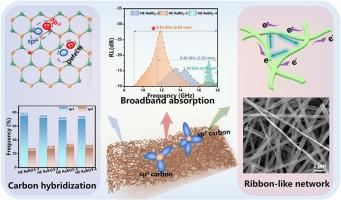Modulation of carbon atom hybridization structure and electromagnetic absorption properties in carbon fiber composites
IF 11.6
2区 材料科学
Q1 CHEMISTRY, PHYSICAL
引用次数: 0
Abstract
Carbon fiber composites exhibit significant potential for electromagnetic wave (EMW) absorption, whereas the practical application is limited by excessive electrical conductivity and a single loss mechanism. Herein, high-entropy borate (HE ReBO3) loaded carbon fiber composites were fabricated by electrospinning, which the fiber morphology and sp2/sp3 hybridized carbon ratios were controlled by borate loading. The results show that the sp2 hybridization carbon ratio increased from 24.28 % to 29.08 %, intensifying dipole polarization loss. Meanwhile, the introduction of HE ReBO3 induced a ribbon-like fiber structure with median diameters of 0.57 μm, which enhanced multiple reflection/scattering of EWM and interface polarization. The synergistic effect between dipole and interface polarization endowed the composite with exceptional absorption properties. The optimal composite (HE ReBO3-3) achieved a minimum reflection loss (RLmin) of −59.41 dB at 2.18 mm thickness and an EAB-10 (RL ≤ −10 dB) of 8.83 GHz, which demonstrated superior broadband and strong absorption performance. This work proposes a carbon hybridization strategy for structural modulation, providing novel insights for designing electromagnetic functional materials.

碳纤维复合材料中碳原子杂化结构和电磁吸收特性的调制
碳纤维复合材料具有显著的电磁波吸收潜力,但其导电性和单一损耗机制限制了其实际应用。采用静电纺丝法制备了高熵硼酸盐(HE ReBO3)负载碳纤维复合材料,并通过硼酸盐负载控制纤维形态和sp2/sp3杂化碳比。结果表明:sp2杂化碳比由24.28%增加到29.08%,偶极子极化损失加剧;同时,HE ReBO3的引入诱导了中值直径为0.57 μm的带状光纤结构,增强了EWM的多次反射/散射和界面极化。偶极子和界面极化的协同作用使复合材料具有优异的吸收性能。最佳复合材料(HE ReBO3-3)在厚度为2.18 mm时的最小反射损耗(RLmin)为- 59.41 dB, EAB-10 (RL≤-10 dB)为8.83 GHz,具有优越的宽带和强吸收性能。这项工作提出了一种结构调制的碳杂化策略,为设计电磁功能材料提供了新的见解。
本文章由计算机程序翻译,如有差异,请以英文原文为准。
求助全文
约1分钟内获得全文
求助全文
来源期刊

Carbon
工程技术-材料科学:综合
CiteScore
20.80
自引率
7.30%
发文量
0
审稿时长
23 days
期刊介绍:
The journal Carbon is an international multidisciplinary forum for communicating scientific advances in the field of carbon materials. It reports new findings related to the formation, structure, properties, behaviors, and technological applications of carbons. Carbons are a broad class of ordered or disordered solid phases composed primarily of elemental carbon, including but not limited to carbon black, carbon fibers and filaments, carbon nanotubes, diamond and diamond-like carbon, fullerenes, glassy carbon, graphite, graphene, graphene-oxide, porous carbons, pyrolytic carbon, and other sp2 and non-sp2 hybridized carbon systems. Carbon is the companion title to the open access journal Carbon Trends. Relevant application areas for carbon materials include biology and medicine, catalysis, electronic, optoelectronic, spintronic, high-frequency, and photonic devices, energy storage and conversion systems, environmental applications and water treatment, smart materials and systems, and structural and thermal applications.
 求助内容:
求助内容: 应助结果提醒方式:
应助结果提醒方式:


